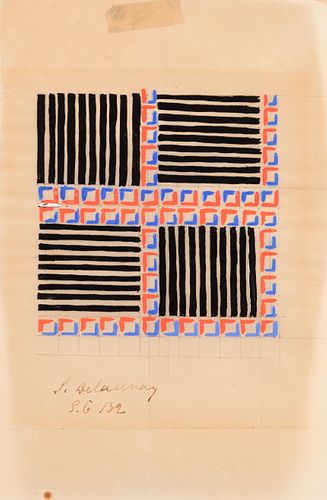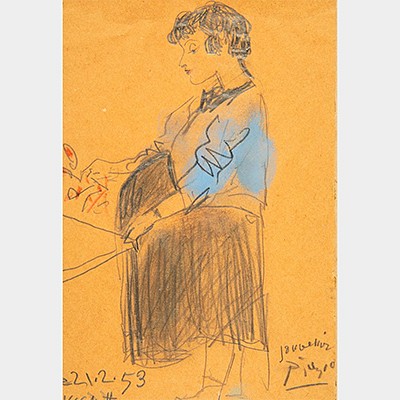SONIA DELAUNAY (Ukraine, 1885 - France, 1979). "Composition," 1932. Gouache and graphite on tracing paper. Attached catalog on the back of the exhibit
Lot 121
About Seller
Setdart Auction House
Carrer Aragó 346
Barcelona
Spain
Setdart Subastas was born in 2004 and is currently the first online art auction in Spain with solidity, prestige and reliability guaranteed by our more than 60,000 users. Setdart has a young, dynamic and enterprising team ready to successfully manage the purchase and sale of art works through custom...Read more
Categories
Estimate:
EUR€8,000 - EUR€9,000
$8,695.65 - $9,782.61
Absentee vs Live bid
Two ways to bid:
- Leave a max absentee bid and the platform will bid on your behalf up to your maximum bid during the live auction.
- Bid live during the auction and your bids will be submitted real-time to the auctioneer.
Bid Increments
| Price | Bid Increment |
|---|---|
| EUR€0 | EUR€10 |
| EUR€200 | EUR€25 |
| EUR€500 | EUR€50 |
| EUR€1,000 | EUR€100 |
| EUR€3,000 | EUR€200 |
| EUR€5,000 | EUR€500 |
| EUR€10,000 | EUR€1,000 |
| EUR€20,000 | EUR€2,000 |
| EUR€50,000 | EUR€5,000 |
About Auction
By Setdart Auction House
Sep 20, 2021
Set Reminder
2021-09-20 08:00:00
2021-09-20 08:00:00
America/New_York
Bidsquare
Bidsquare : CONTEMPORARY ART
https://www.bidsquare.com/auctions/setdart-auction-house/contemporary-art-7482
Setdart Auction House sofia@setdart.com
Setdart Auction House sofia@setdart.com
- Lot Description
SONIA DELAUNAY (Ukraine, 1885 - France, 1979). "Composition," 1932. Gouache and graphite on tracing paper. Attached catalog on the back of the exhibition held at the Blu Gallery (Milan) in 76-77. Signed in the lower left corner. Measurements: 40 x 37 cm. Provenance: -Marconi Gallery, Milan. -Private collection, acquired between 1975 and 1978. -Christie's Paris, June 16. Live auction 19614, "Women in art", lot 59. -Private collection, Madrid With her characteristic synthetic style, in this piece Delaunay, forms a geometric composition, where she combines different lines arranged through various strokes, thus creating an image that is somewhat reminiscent of op art. However, despite the prominence of the forms, it is necessary to mention the use of color that the artist makes, merging complementary shades, as a slight reminiscence of the work she developed with her husband, both creators of Orphic Cubism. Born Sonia Ilínichna Stern, Sonia Delaunay is better known by her married name, which she adopted after marrying Robert Delaunay. A French painter and designer of Ukrainian origin, she was, along with her husband, one of the main representatives of abstract art, as well as the creator of simultanism. She grew up in St. Petersburg, in contact with the collection of paintings of the Barbizon School of her uncle and with the cultural life of the city. In 1903 she moved to Germany to further her education, where she discovered contemporary painting and studied drawing with Schmidt-Reuter. Two years later he moved to Paris and enrolled in the Academie de la Palette, where he was also initiated in engraving by Grossman. During these years he approached the European avant-garde through German expressionism, with a work that also reveals echoes of post-impressionism. In 1908 he held his first exhibition, showing works from his recently initiated Fauvist period. Two years later he married Delaunay, with whom he shared aesthetic concerns. Their art then underwent a change of direction, towards abstraction. The artist will then move towards the decorative arts, always with a purely abstract colorist language that will attract the attention of her peers and also of the critics. Although in 1912 she returned to painting, her fame as a designer had already been established throughout Europe. From then on she would frequently participate in important European exhibitions, such as the Berlin Autumn Salon or the Salon des Indépendants in Paris. During the First World War she lived in Spain and Portugal, where she developed an intense creative activity, including collaboration with Diaghilev's ballet. In 1921 the couple returned to Paris, where Sonia Delaunay continued to work on important projects, in addition to exhibiting her work both in Europe and the United States. Already fully recognized from the fifties onwards, compilations of her work began to be published, and in fact in 1958 her first retrospective exhibition was dedicated to her in Bielefeld (Germany). In addition, in 1975 she was made an officer of the French Legion of Honor. Currently Delaunay is represented in major collections around the world, including the MoMA in New York, the Hermitage in St. Petersburg, the Reina Sofia in Madrid, the Albertina in Vienna and Haifa in Israel.
- Shipping Info
-
In-house shipping available. Please inquire at admin@setdart.com.
-
- Buyer's Premium



 EUR
EUR CAD
CAD AUD
AUD GBP
GBP MXN
MXN HKD
HKD CNY
CNY MYR
MYR SEK
SEK SGD
SGD CHF
CHF THB
THB
















